Capital Budgeting and Cost Analysis: A Report on the US DoD
VerifiedAdded on 2020/04/13
|10
|1778
|392
Report
AI Summary
This report examines the capital budgeting practices of the US Department of Defense (DoD). It explores the methods currently employed, including performance-based budgeting and the consideration of lifecycle costs for assets. The analysis covers the DoD's computation of cash flows, both before and after tax, and the determination of its weighted average cost of capital (WACC). The report highlights the significant financial resources allocated by the DoD, its electricity consumption, fuel usage, and the overall impact on the US GDP. The report also includes data on cargo and passenger rates, reflecting the financial considerations within the DoD's operations. The report concludes by summarizing the key findings regarding the DoD's capital budgeting approach, emphasizing the importance of lifecycle cost analysis and the use of zone-to-zone dollar rates for shipment calculations. References are provided for further research.

Running head: CAPITAL BUDGETING
Capital Budgeting
Name of Student:
Name of University:
Author’s Note:
Capital Budgeting
Name of Student:
Name of University:
Author’s Note:
Paraphrase This Document
Need a fresh take? Get an instant paraphrase of this document with our AI Paraphraser
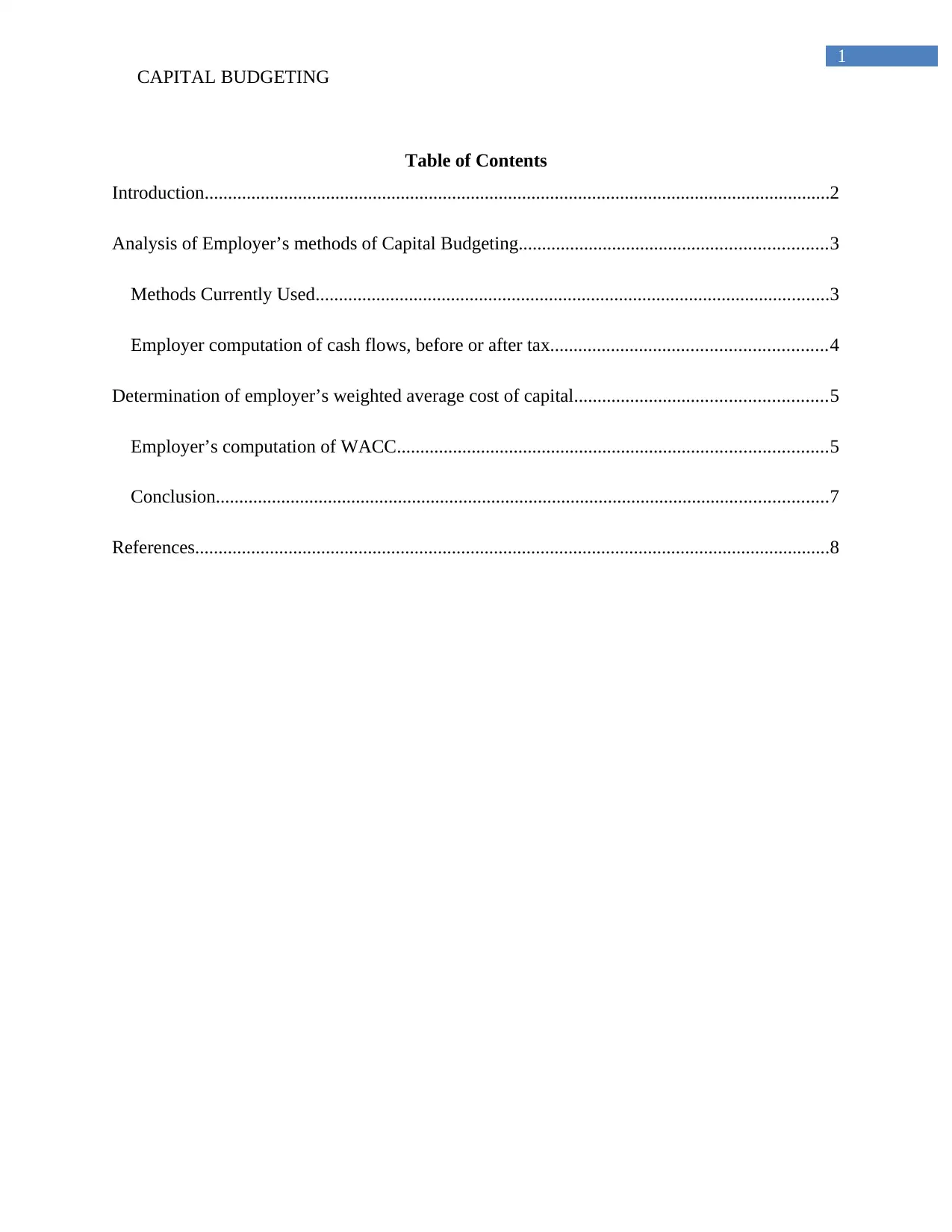
1
CAPITAL BUDGETING
Table of Contents
Introduction......................................................................................................................................2
Analysis of Employer’s methods of Capital Budgeting..................................................................3
Methods Currently Used..............................................................................................................3
Employer computation of cash flows, before or after tax...........................................................4
Determination of employer’s weighted average cost of capital......................................................5
Employer’s computation of WACC............................................................................................5
Conclusion...................................................................................................................................7
References........................................................................................................................................8
CAPITAL BUDGETING
Table of Contents
Introduction......................................................................................................................................2
Analysis of Employer’s methods of Capital Budgeting..................................................................3
Methods Currently Used..............................................................................................................3
Employer computation of cash flows, before or after tax...........................................................4
Determination of employer’s weighted average cost of capital......................................................5
Employer’s computation of WACC............................................................................................5
Conclusion...................................................................................................................................7
References........................................................................................................................................8

2
CAPITAL BUDGETING
Introduction
The “Department of Defence (DoD, USDOD, or DOD)” is identified as the executive
branch of the federal government of US which has been charged with the coordination and
supervision of the agency functions and concern for the national security and US armed forces.
The department largest is identified with more than “1.3 million active duty serviceman and
women of 2016”. The department is seen to be headed by the secretary of Defence by the
Secretary of Defence and cabinet level head who is identified to report directly to the president
of US. Beneath the Department of Defence the three subordinate military departments such as
“United States Department of the Army, the United States Department of the Navy, and the
United States Department of the Air Force” (Department of Defense & Defense, 2017).
The report is intended to analyse the employer’s method for capital budgeting. Some of
the other aspects of the report have further aimed to discuss on the Methods Currently Used,
Analysis of Employer’s methods of Capital Budgeting and Employer computation of cash flows,
before or after tax.
CAPITAL BUDGETING
Introduction
The “Department of Defence (DoD, USDOD, or DOD)” is identified as the executive
branch of the federal government of US which has been charged with the coordination and
supervision of the agency functions and concern for the national security and US armed forces.
The department largest is identified with more than “1.3 million active duty serviceman and
women of 2016”. The department is seen to be headed by the secretary of Defence by the
Secretary of Defence and cabinet level head who is identified to report directly to the president
of US. Beneath the Department of Defence the three subordinate military departments such as
“United States Department of the Army, the United States Department of the Navy, and the
United States Department of the Air Force” (Department of Defense & Defense, 2017).
The report is intended to analyse the employer’s method for capital budgeting. Some of
the other aspects of the report have further aimed to discuss on the Methods Currently Used,
Analysis of Employer’s methods of Capital Budgeting and Employer computation of cash flows,
before or after tax.
⊘ This is a preview!⊘
Do you want full access?
Subscribe today to unlock all pages.

Trusted by 1+ million students worldwide
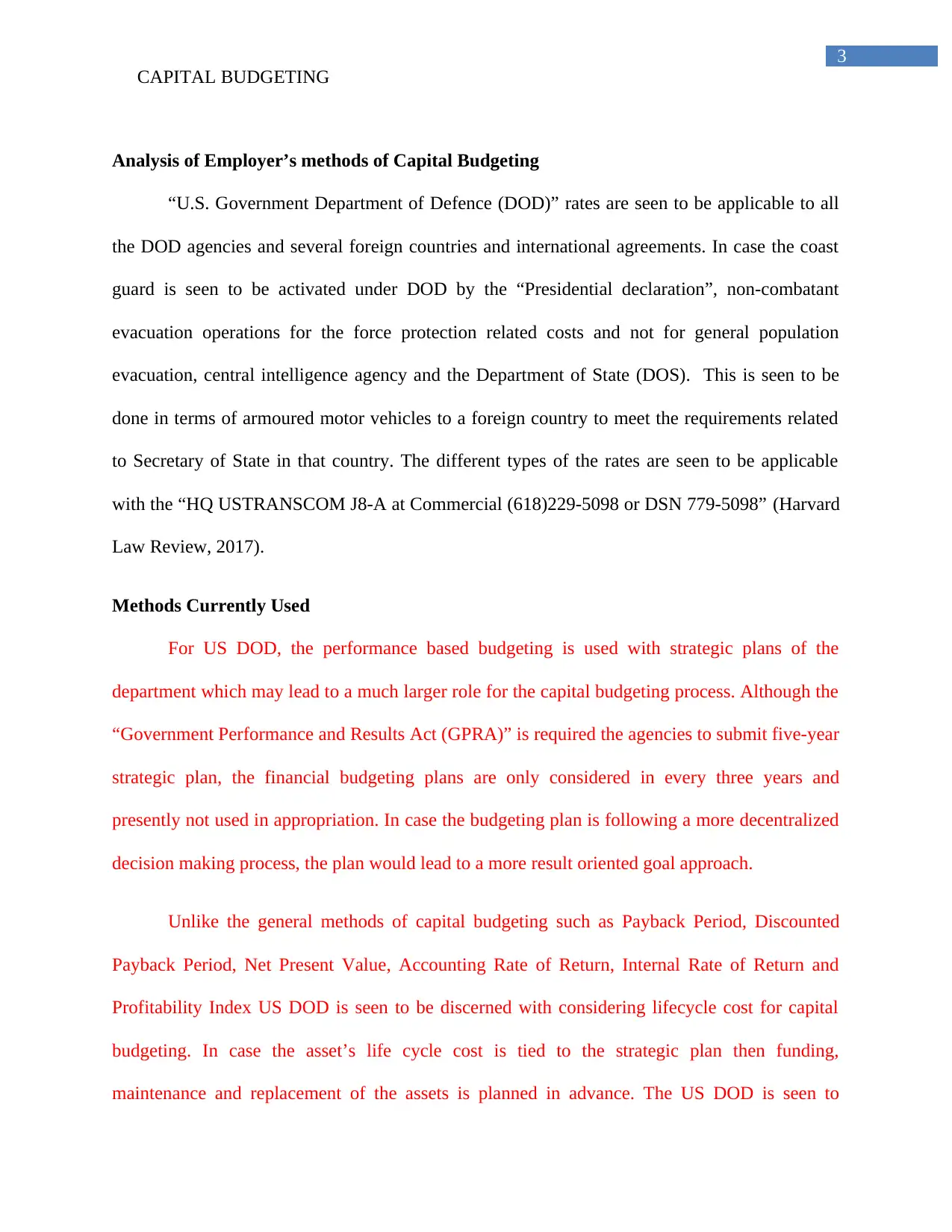
3
CAPITAL BUDGETING
Analysis of Employer’s methods of Capital Budgeting
“U.S. Government Department of Defence (DOD)” rates are seen to be applicable to all
the DOD agencies and several foreign countries and international agreements. In case the coast
guard is seen to be activated under DOD by the “Presidential declaration”, non-combatant
evacuation operations for the force protection related costs and not for general population
evacuation, central intelligence agency and the Department of State (DOS). This is seen to be
done in terms of armoured motor vehicles to a foreign country to meet the requirements related
to Secretary of State in that country. The different types of the rates are seen to be applicable
with the “HQ USTRANSCOM J8-A at Commercial (618)229-5098 or DSN 779-5098” (Harvard
Law Review, 2017).
Methods Currently Used
For US DOD, the performance based budgeting is used with strategic plans of the
department which may lead to a much larger role for the capital budgeting process. Although the
“Government Performance and Results Act (GPRA)” is required the agencies to submit five-year
strategic plan, the financial budgeting plans are only considered in every three years and
presently not used in appropriation. In case the budgeting plan is following a more decentralized
decision making process, the plan would lead to a more result oriented goal approach.
Unlike the general methods of capital budgeting such as Payback Period, Discounted
Payback Period, Net Present Value, Accounting Rate of Return, Internal Rate of Return and
Profitability Index US DOD is seen to be discerned with considering lifecycle cost for capital
budgeting. In case the asset’s life cycle cost is tied to the strategic plan then funding,
maintenance and replacement of the assets is planned in advance. The US DOD is seen to
CAPITAL BUDGETING
Analysis of Employer’s methods of Capital Budgeting
“U.S. Government Department of Defence (DOD)” rates are seen to be applicable to all
the DOD agencies and several foreign countries and international agreements. In case the coast
guard is seen to be activated under DOD by the “Presidential declaration”, non-combatant
evacuation operations for the force protection related costs and not for general population
evacuation, central intelligence agency and the Department of State (DOS). This is seen to be
done in terms of armoured motor vehicles to a foreign country to meet the requirements related
to Secretary of State in that country. The different types of the rates are seen to be applicable
with the “HQ USTRANSCOM J8-A at Commercial (618)229-5098 or DSN 779-5098” (Harvard
Law Review, 2017).
Methods Currently Used
For US DOD, the performance based budgeting is used with strategic plans of the
department which may lead to a much larger role for the capital budgeting process. Although the
“Government Performance and Results Act (GPRA)” is required the agencies to submit five-year
strategic plan, the financial budgeting plans are only considered in every three years and
presently not used in appropriation. In case the budgeting plan is following a more decentralized
decision making process, the plan would lead to a more result oriented goal approach.
Unlike the general methods of capital budgeting such as Payback Period, Discounted
Payback Period, Net Present Value, Accounting Rate of Return, Internal Rate of Return and
Profitability Index US DOD is seen to be discerned with considering lifecycle cost for capital
budgeting. In case the asset’s life cycle cost is tied to the strategic plan then funding,
maintenance and replacement of the assets is planned in advance. The US DOD is seen to
Paraphrase This Document
Need a fresh take? Get an instant paraphrase of this document with our AI Paraphraser
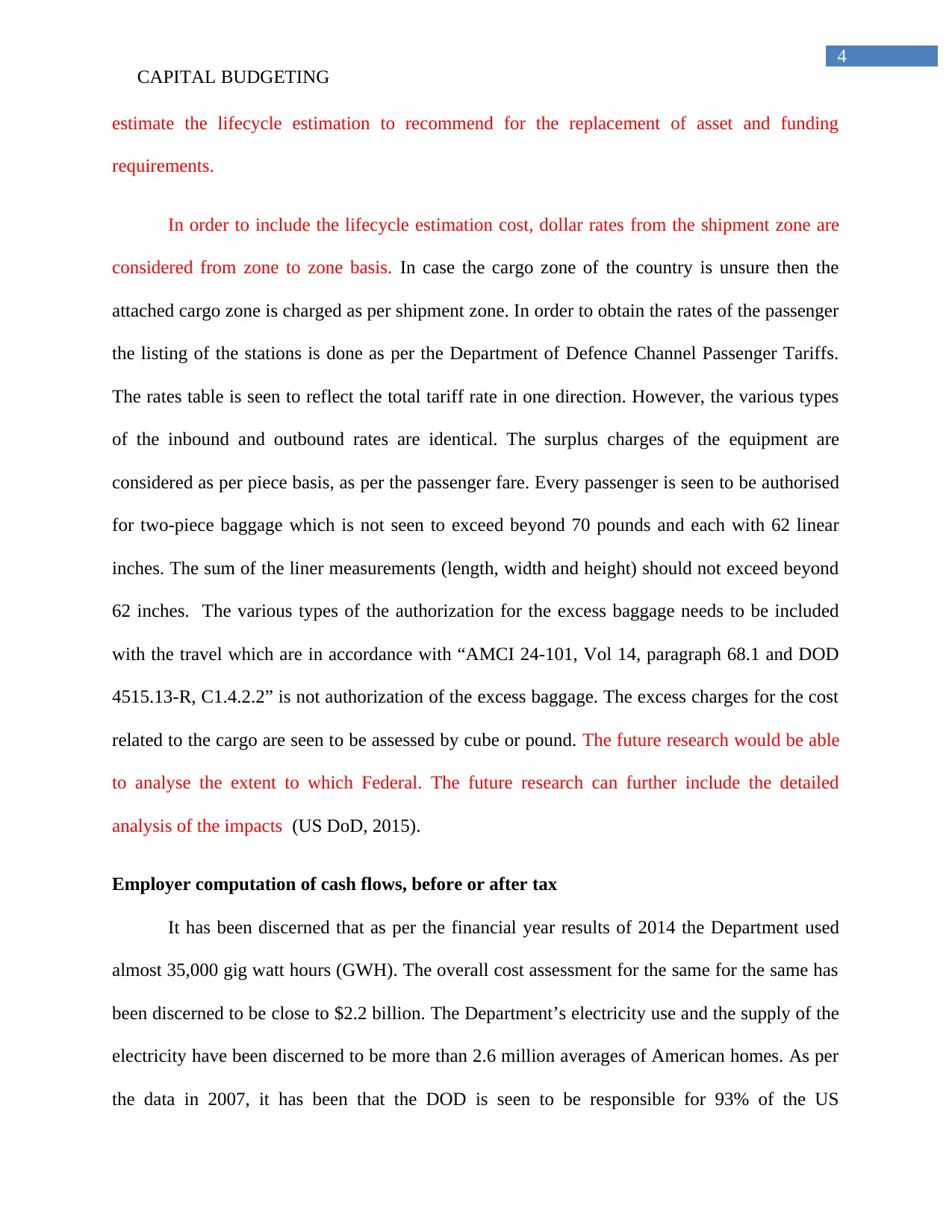
4
CAPITAL BUDGETING
estimate the lifecycle estimation to recommend for the replacement of asset and funding
requirements.
In order to include the lifecycle estimation cost, dollar rates from the shipment zone are
considered from zone to zone basis. In case the cargo zone of the country is unsure then the
attached cargo zone is charged as per shipment zone. In order to obtain the rates of the passenger
the listing of the stations is done as per the Department of Defence Channel Passenger Tariffs.
The rates table is seen to reflect the total tariff rate in one direction. However, the various types
of the inbound and outbound rates are identical. The surplus charges of the equipment are
considered as per piece basis, as per the passenger fare. Every passenger is seen to be authorised
for two-piece baggage which is not seen to exceed beyond 70 pounds and each with 62 linear
inches. The sum of the liner measurements (length, width and height) should not exceed beyond
62 inches. The various types of the authorization for the excess baggage needs to be included
with the travel which are in accordance with “AMCI 24-101, Vol 14, paragraph 68.1 and DOD
4515.13-R, C1.4.2.2” is not authorization of the excess baggage. The excess charges for the cost
related to the cargo are seen to be assessed by cube or pound. The future research would be able
to analyse the extent to which Federal. The future research can further include the detailed
analysis of the impacts (US DoD, 2015).
Employer computation of cash flows, before or after tax
It has been discerned that as per the financial year results of 2014 the Department used
almost 35,000 gig watt hours (GWH). The overall cost assessment for the same for the same has
been discerned to be close to $2.2 billion. The Department’s electricity use and the supply of the
electricity have been discerned to be more than 2.6 million averages of American homes. As per
the data in 2007, it has been that the DOD is seen to be responsible for 93% of the US
CAPITAL BUDGETING
estimate the lifecycle estimation to recommend for the replacement of asset and funding
requirements.
In order to include the lifecycle estimation cost, dollar rates from the shipment zone are
considered from zone to zone basis. In case the cargo zone of the country is unsure then the
attached cargo zone is charged as per shipment zone. In order to obtain the rates of the passenger
the listing of the stations is done as per the Department of Defence Channel Passenger Tariffs.
The rates table is seen to reflect the total tariff rate in one direction. However, the various types
of the inbound and outbound rates are identical. The surplus charges of the equipment are
considered as per piece basis, as per the passenger fare. Every passenger is seen to be authorised
for two-piece baggage which is not seen to exceed beyond 70 pounds and each with 62 linear
inches. The sum of the liner measurements (length, width and height) should not exceed beyond
62 inches. The various types of the authorization for the excess baggage needs to be included
with the travel which are in accordance with “AMCI 24-101, Vol 14, paragraph 68.1 and DOD
4515.13-R, C1.4.2.2” is not authorization of the excess baggage. The excess charges for the cost
related to the cargo are seen to be assessed by cube or pound. The future research would be able
to analyse the extent to which Federal. The future research can further include the detailed
analysis of the impacts (US DoD, 2015).
Employer computation of cash flows, before or after tax
It has been discerned that as per the financial year results of 2014 the Department used
almost 35,000 gig watt hours (GWH). The overall cost assessment for the same for the same has
been discerned to be close to $2.2 billion. The Department’s electricity use and the supply of the
electricity have been discerned to be more than 2.6 million averages of American homes. As per
the data in 2007, it has been that the DOD is seen to be responsible for 93% of the US

5
CAPITAL BUDGETING
government consumption of fuel. It has been further seen to be discerned that Department of Air
Force has been discerned with 52% consumption of Department of the Air Force. It has been
also seen that the total consumption by the Department of the Navy is 33%; Department of the
Army 7% and other Department components is 1%. The main consideration for the spending of
DOD is identified to be 4.8% of the total GDP amount in 4.8%. This has accounted for 45% of
the budgeted global military spending and more than 17 largest militaries combined (Sharkey et
al., 2014).
Determination of employer’s weighted average cost of capital
The various types of the determination of the cost consideration have been discerned with
$585 billion. The highest level of the resource for budget has been applied with the budgetary
resources among all Federal agencies. The total amount of one half of the annual Federal
Expenditures is US is considered with the federal discretionary budget (Perdue et al., 2015).
Employer’s computation of WACC
The main form of the method used to compute the cost of capital has been discerned with
the use of Average Channel Cargo Zone Rates. For the computation of the cost of the cargo
estimates, the request of the rates is made to “HQ USTRANSCOM/J8-CA at DSN 779-5074 or
779-5061, commercial”.
CAPITAL BUDGETING
government consumption of fuel. It has been further seen to be discerned that Department of Air
Force has been discerned with 52% consumption of Department of the Air Force. It has been
also seen that the total consumption by the Department of the Navy is 33%; Department of the
Army 7% and other Department components is 1%. The main consideration for the spending of
DOD is identified to be 4.8% of the total GDP amount in 4.8%. This has accounted for 45% of
the budgeted global military spending and more than 17 largest militaries combined (Sharkey et
al., 2014).
Determination of employer’s weighted average cost of capital
The various types of the determination of the cost consideration have been discerned with
$585 billion. The highest level of the resource for budget has been applied with the budgetary
resources among all Federal agencies. The total amount of one half of the annual Federal
Expenditures is US is considered with the federal discretionary budget (Perdue et al., 2015).
Employer’s computation of WACC
The main form of the method used to compute the cost of capital has been discerned with
the use of Average Channel Cargo Zone Rates. For the computation of the cost of the cargo
estimates, the request of the rates is made to “HQ USTRANSCOM/J8-CA at DSN 779-5074 or
779-5061, commercial”.
⊘ This is a preview!⊘
Do you want full access?
Subscribe today to unlock all pages.

Trusted by 1+ million students worldwide
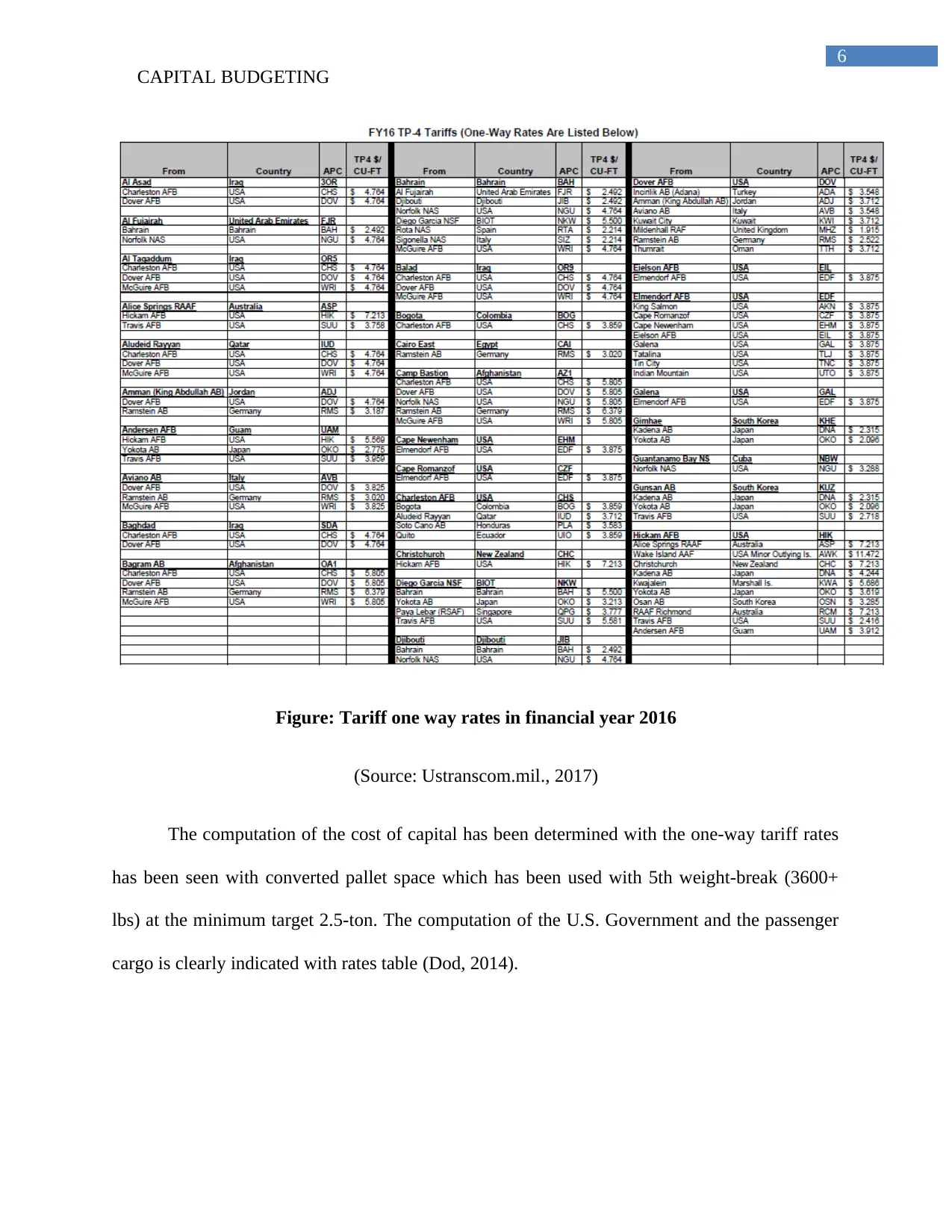
6
CAPITAL BUDGETING
Figure: Tariff one way rates in financial year 2016
(Source: Ustranscom.mil., 2017)
The computation of the cost of capital has been determined with the one-way tariff rates
has been seen with converted pallet space which has been used with 5th weight-break (3600+
lbs) at the minimum target 2.5-ton. The computation of the U.S. Government and the passenger
cargo is clearly indicated with rates table (Dod, 2014).
CAPITAL BUDGETING
Figure: Tariff one way rates in financial year 2016
(Source: Ustranscom.mil., 2017)
The computation of the cost of capital has been determined with the one-way tariff rates
has been seen with converted pallet space which has been used with 5th weight-break (3600+
lbs) at the minimum target 2.5-ton. The computation of the U.S. Government and the passenger
cargo is clearly indicated with rates table (Dod, 2014).
Paraphrase This Document
Need a fresh take? Get an instant paraphrase of this document with our AI Paraphraser

7
CAPITAL BUDGETING
Conclusion
The main form of the depiction of the report has been able to state that the main form of
the depiction of the capital budgeting method has been seen with the use of dollar rates from the
shipment zone are considered from zone to zone basis. It has been further discerned that US
DOD method of capital budgeting is based on lifecycle cost for capital budgeting. The
Department’s electricity use and the supply of the electricity have been discerned to be more
than 2.6 million averages of American homes. As per the data in 2007, it has been that the DOD
is seen to be responsible for 93% of the US government consumption of fuel. It has been further
seen to be discerned that Department of Air Force has been discerned with 52% consumption of
Department of the Air Force.
CAPITAL BUDGETING
Conclusion
The main form of the depiction of the report has been able to state that the main form of
the depiction of the capital budgeting method has been seen with the use of dollar rates from the
shipment zone are considered from zone to zone basis. It has been further discerned that US
DOD method of capital budgeting is based on lifecycle cost for capital budgeting. The
Department’s electricity use and the supply of the electricity have been discerned to be more
than 2.6 million averages of American homes. As per the data in 2007, it has been that the DOD
is seen to be responsible for 93% of the US government consumption of fuel. It has been further
seen to be discerned that Department of Air Force has been discerned with 52% consumption of
Department of the Air Force.
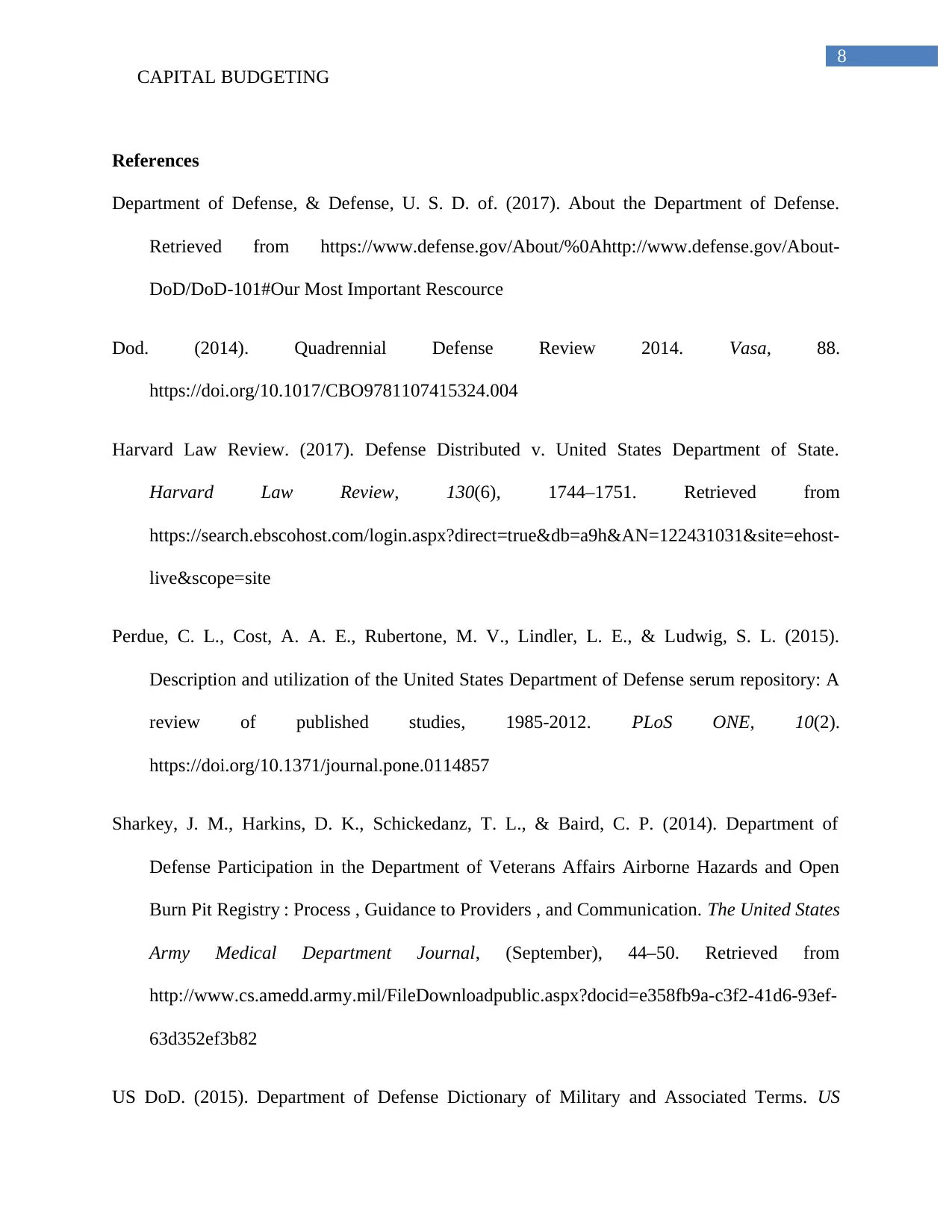
8
CAPITAL BUDGETING
References
Department of Defense, & Defense, U. S. D. of. (2017). About the Department of Defense.
Retrieved from https://www.defense.gov/About/%0Ahttp://www.defense.gov/About-
DoD/DoD-101#Our Most Important Rescource
Dod. (2014). Quadrennial Defense Review 2014. Vasa, 88.
https://doi.org/10.1017/CBO9781107415324.004
Harvard Law Review. (2017). Defense Distributed v. United States Department of State.
Harvard Law Review, 130(6), 1744–1751. Retrieved from
https://search.ebscohost.com/login.aspx?direct=true&db=a9h&AN=122431031&site=ehost-
live&scope=site
Perdue, C. L., Cost, A. A. E., Rubertone, M. V., Lindler, L. E., & Ludwig, S. L. (2015).
Description and utilization of the United States Department of Defense serum repository: A
review of published studies, 1985-2012. PLoS ONE, 10(2).
https://doi.org/10.1371/journal.pone.0114857
Sharkey, J. M., Harkins, D. K., Schickedanz, T. L., & Baird, C. P. (2014). Department of
Defense Participation in the Department of Veterans Affairs Airborne Hazards and Open
Burn Pit Registry : Process , Guidance to Providers , and Communication. The United States
Army Medical Department Journal, (September), 44–50. Retrieved from
http://www.cs.amedd.army.mil/FileDownloadpublic.aspx?docid=e358fb9a-c3f2-41d6-93ef-
63d352ef3b82
US DoD. (2015). Department of Defense Dictionary of Military and Associated Terms. US
CAPITAL BUDGETING
References
Department of Defense, & Defense, U. S. D. of. (2017). About the Department of Defense.
Retrieved from https://www.defense.gov/About/%0Ahttp://www.defense.gov/About-
DoD/DoD-101#Our Most Important Rescource
Dod. (2014). Quadrennial Defense Review 2014. Vasa, 88.
https://doi.org/10.1017/CBO9781107415324.004
Harvard Law Review. (2017). Defense Distributed v. United States Department of State.
Harvard Law Review, 130(6), 1744–1751. Retrieved from
https://search.ebscohost.com/login.aspx?direct=true&db=a9h&AN=122431031&site=ehost-
live&scope=site
Perdue, C. L., Cost, A. A. E., Rubertone, M. V., Lindler, L. E., & Ludwig, S. L. (2015).
Description and utilization of the United States Department of Defense serum repository: A
review of published studies, 1985-2012. PLoS ONE, 10(2).
https://doi.org/10.1371/journal.pone.0114857
Sharkey, J. M., Harkins, D. K., Schickedanz, T. L., & Baird, C. P. (2014). Department of
Defense Participation in the Department of Veterans Affairs Airborne Hazards and Open
Burn Pit Registry : Process , Guidance to Providers , and Communication. The United States
Army Medical Department Journal, (September), 44–50. Retrieved from
http://www.cs.amedd.army.mil/FileDownloadpublic.aspx?docid=e358fb9a-c3f2-41d6-93ef-
63d352ef3b82
US DoD. (2015). Department of Defense Dictionary of Military and Associated Terms. US
⊘ This is a preview!⊘
Do you want full access?
Subscribe today to unlock all pages.

Trusted by 1+ million students worldwide

9
CAPITAL BUDGETING
Department of Defense Joint Publication, 2001(June), 513.
https://doi.org/10.1080/14777622.2016.1237212 U6 -
https://www.scopus.com/inward/record.uri?eid=2-s2.0-
85003550236&doi=10.1080%2f14777622.2016.1237212&partnerID=40&md5=063c6b04f
6b1364a44a9081b3e602227 M4 - Citavi
Ustranscom.mil. (2017). Retrieved 19 November 2017, from
https://www.ustranscom.mil/dbw/docs/FY16_Department_of_Defense_Airlift_Instructio
ns_and_Rates.pdf
CAPITAL BUDGETING
Department of Defense Joint Publication, 2001(June), 513.
https://doi.org/10.1080/14777622.2016.1237212 U6 -
https://www.scopus.com/inward/record.uri?eid=2-s2.0-
85003550236&doi=10.1080%2f14777622.2016.1237212&partnerID=40&md5=063c6b04f
6b1364a44a9081b3e602227 M4 - Citavi
Ustranscom.mil. (2017). Retrieved 19 November 2017, from
https://www.ustranscom.mil/dbw/docs/FY16_Department_of_Defense_Airlift_Instructio
ns_and_Rates.pdf
1 out of 10
Related Documents
Your All-in-One AI-Powered Toolkit for Academic Success.
+13062052269
info@desklib.com
Available 24*7 on WhatsApp / Email
![[object Object]](/_next/static/media/star-bottom.7253800d.svg)
Unlock your academic potential
Copyright © 2020–2025 A2Z Services. All Rights Reserved. Developed and managed by ZUCOL.




